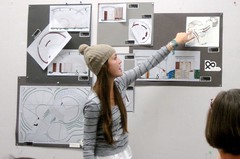Making Learning Visible to Increase Student Engagement
On March 13, I will be presenting on "Making Learning Visible to Increase Student Engagement" at the NJEDge Faculty Showcase. This "Best Practices" presentation was inspired in part by the educational research from the Project Zero group at the Harvard Graduate School of Education.
I will be talking about the practice of using a public forum in both undergraduate and graduate online and face-to-face classes (at NJIT and at Montclair State University) and having students publicly reflect on their learning experiences.
 Requiring students to document their work in a class forum immediately changes student ownership of their work. This type of documentation makes learning visible, rather than the private 1:1 relationship that assessment and evaluation often has between a student and instructor.
Requiring students to document their work in a class forum immediately changes student ownership of their work. This type of documentation makes learning visible, rather than the private 1:1 relationship that assessment and evaluation often has between a student and instructor.
I will explain the documentation and process reflection methodology and show student examples. This practice borrows on earlier use of and the pedagogy of portfolios.
The Making Learning Visible (MLV) Project was based on collaborative research between Project Zero researchers and educators from the Municipal Preschools of Reggio Emilia, Italy. MLV investigated how best to understand, document, and support individual and group learning for children and adults. I read about it in


In particular, the aspect of learning and teaching in MLV that I identify most strongly with is the role of observation and documentation in deepening and extending learning.
 Documentation involves one or more specific questions that guide the process, often with an epistemological focus (questions on learning).
Documentation involves one or more specific questions that guide the process, often with an epistemological focus (questions on learning).
Documentation also involves collectively analyzing, interpreting, and evaluating individual and group observations. (It's interesting that the keynote speaker at the Showcase next month will be Etienne Wenger-Trayner
This process is strengthened by multiple perspectives and so it is necessary to make the learning visible. It becomes public when it is shared with other learners, parents, teachers or the public.
Prompting reflective thinking during learning helps learners develop strategies to apply new knowledge to the complex situations in their day-to-day activities. Reflective thinking helps learners attach new knowledge to prior understanding, and also understand their own thinking and learning strategies.
I find that this practice is also very beneficial to me as an instructor in grading student work as it reveals the hidden process that cannot be seen in only grading a final product.
Ultimately, I have found that this is another way to promote student engagement. Teachers in K-12 have known intuitively that displaying student work lets students know that their work is valued and that the classroom space is shared.

Sample student infographic by Anabel Damstrom as posted within the course LMS
with her process reflection and also on her public portfolio.
Comments
No comments